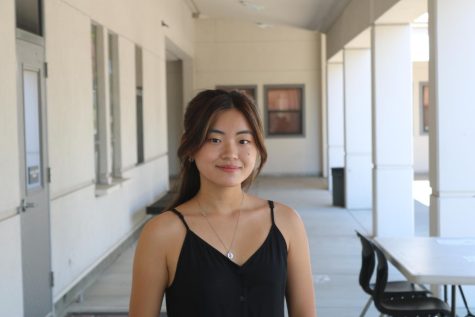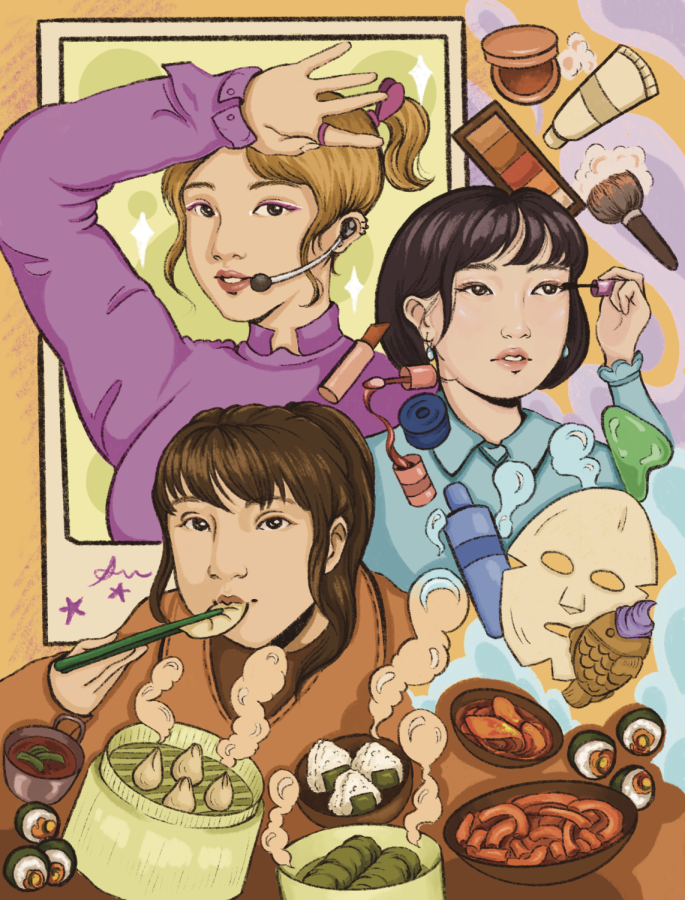Asian trends mislabeled
Chinese trends problematically mistaken for other cultures
Illustration by Susanne Soroushian
Different Eastern influences have been popularized in the West, from K-pop to dim sum to unique make-up styles.
From K-pop to clean skincare to makeup, Asian trends have been increasing in popularity in the West recently.
These trends can be observed in the beauty community on TikTok, as well as other streaming services such as YouTube and Netflix. In recent years, East Asian media trends have had great success in the United States. But an issue arises when specific East Asian cultures are mistaken for each other.
Korean skincare, K-dramas, and K-pop have seen a huge boom in Western media and trends in recent years, not to mention the popularity of anime and Japanese food such as sushi and ramen.
“It’s been really fun seeing [Asian trends] explode everywhere,” junior Vivian Vang said.
According to The Guardian, South Korea’s entertainment industry has had great success in the United States, with K-pop groups such as BTS and Blackpink, which topped the Billboard charts.
Additionally, shows such as Squid Game, which became the most-watched Netflix show in history, have also been seeing more success in Western viewing charts as well.
But Chinese cultural trends have generally seen much less exposure in Western media.
“It seems like what’s popularized most is Korean and Japanese styles,” English Social Justice and Community teacher Ashley Tran said. “Chinese styles, although they’ve been around for a while, aren’t as recognized or people don’t know that [the trends are] originally from China.”
When compared to other East Asian countries such as Japan and South Korea, the difference in acceptance of culture is clear. K-pop is played on our radios and anime is broadcast in our theaters. But Chinese trends are oddly absent, suppressed or mislabeled as Japanese or Korean.
“I feel like [Chinese trends] get rebranded a lot as the Korean or Japanese look. It’s not really fair because it came from China,” Vang said. “Korean and Japanese influence has spread a lot more through K-pop and anime. But Chinese influence hasn’t spread that much.”
Some Chinese trends such as Douyin and Xiaohongshu makeup, specific styles of makeup originating from and named after Chinese social media apps, have managed to gain traction on American social media.
However, these trends have been mislabeled as Japanese or Korean; cultures that already have their own respective styles. This miscrediting is a false representation and attribution of East Asian cultures. This is specifically a problem when it comes to attributing Chinese culture and is due to sinophobia.
Sinophobia, or anti-Chinese sentiment, has been expressed in the United States since before the Chinese Exclusion Act in 1882, where Chinese labor workers were banned from immigrating to the United States. Although this was over 140 years ago, many Americans still view Chinese people negatively.
According to a 2021 survey conducted by the Pew Research Center, 67% of Americans have “cold” feelings towards Chinese people and rated their feelings towards Chinese people as below 50 on a feeling thermometer, where 0 was very negative and 100 was very positive. This has increased from 23% in 2018 to 47% now.
These negative feelings toward China are why Chinese trends are less accepted.
“I definitely think people can’t tell the difference between whether something is Chinese or Korean or Japanese,” senior Kylie Chung said. “But there’s obviously a difference there. People don’t want to accept that [trends] that are popularized from China because maybe they believe that we started COVID.”
In addition to these negative feelings, China is already on rocky terms with the United States politically, which only gives more reason for people to relabel Chinese trends as Korean or Japanese.
During the COVID-19 pandemic, the president at the time, Donald Trump, reinforced the narrative that China was at fault for the spread of the coronavirus, which increased animosity towards China as people looked for someone to blame for the pandemic.
Trump’s use of phrases such as “Kung flu” and “Chinese virus” perpetuated the narrative that China, and by extension the Chinese people living in the United States, were at fault for the coronavirus.
The use of this rhetoric not only negatively affected Chinese people, but all East Asians as the frequency of anti-Asian hate increased nationally after the COVID-19 pandemic, according to aapihatecrimes.org. Over 9,000 hate crime incidents were reported from March 19, 2020 to June 30, 2021.
The erasure of Chinese culture in preference of more desirable East Asian cultures like Japan and South Korea has been an increasing issue in the media.
“China should get their credit for [their trends],” Vang said.

Senior Daphne So back again at the Californian for her third year, this time as co-Editor-in-Chief. She has a crippling YesStyle addiction, which is the...






L • Mar 26, 2024 at 1:37 pm
“According to a 2021 survey conducted by the Pew Research Center, 67% of Americans have “cold” feelings towards Chinese people and rated their feelings towards Chinese people as below 50 on a feeling thermometer, where 0 was very negative and 100 was very positive. This has increased from 23% in 2018 to 47% now.”
This is misleading. The study did not survey opinion on Chinese people, it studied opinion on China. They specifically state that “Americans rarely brought up the Chinese people or the country’s long history and culture.”